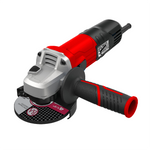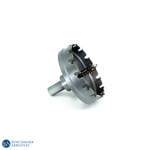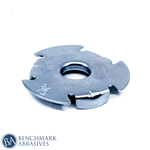
Spade Bit Vs Forstner Bit Vs Hole Saw: Pros and Cons

For a new woodworker, it is not easy to identify the difference between a spade bit, Forstner bit, or hole saw. However, these three drill bits are wood drill bits and are utilized for a similar purpose. These wood boring drill bits can make different types of holes depending on the size of the hole, rough or smooth holes, and the number of holes.
Whether you are a beginner or a professional in woodworking, you must understand the basics of wood boring drill bits. While choosing between spade bit, Forstner bit, or hole saw, you should know the difference between them.
Today through this article, we will let you know the difference between these three essential wood drill bits, along with what these drill bits are and what they are used for.
What are Spade Bit, Forstner Bit, and Hole Saw?
To get a clean and perfect hole in wood, you should know the basics of wood drill bits, such as their size, speed, type of cut, material, and application. And for that, first, understand what spade bit, Forstner bit, and hole saw are.
Spade bit or Paddle bit
A spade bit looks like a spade (digging tool) used to drill holes in wood. They are also known by their other name, "paddle bits." Spade drill bits have two sharp, flat blades in the center that rotate (when attached with a drill) and drill holes in wood by throwing away wood shavings and wood dust.
Many woodworkers use spade bits to make flat-bottomed holes. However, they are used to make a large number of rough holes. Therefore, if you are not concerned about the quality of the holes and want to drill the number of holes in less time, prefer spade bits. The spade drill bit can be fast, easy, and comfortable, but the result could be better.
What is a Spade Bit Used For
Spade bits are mainly used for drilling rough holes in wood and for making multiple holes in a short time.
Spade bits are used to make rough holes in wood. Since they produce rough holes, spade bits are usually used to drill in areas that are not normally visible. Electricians and plumbers use spade bits to drill holes in wood to attach wires or pipes. Spade bits can quickly cut all types of wood, including plywood and plastic materials.
Read More: How to Use a Spade bit
Pros and Cons of Using Spade Bit
|
PROS |
CONS |
|
Easy and Fast drilling. |
Provide only rough holes. |
|
Provide flat-bottomed and complete holes. |
Holes quality can be irregular. |
|
Can drill multiple holes in a short time. |
Holes contain wood fragments and splinters. |
|
There is less risk of overheating. |
It can deform while drilling. |
|
Less costly. |
Not suitable for getting well-finished holes. |
Forstner bit
A Forstner bit is similar to a spade bit; it is also used to drill holes in wood. What makes Forstner bits different from spade bits is that they can drill neat and clean flat bottom holes, whereas spade bits make rough holes.
A Forstner bit was named after its inventor Benjamin Forstner, who was born in 1874.
The Forstner bit features a sharp tip in the middle and two rounded blades to cut the wood, which helps the drill bit move smoothly into the wood. They are made of high-speed steel. Most woodworkers use a Forstner bit with a power drill, but they can also be attached with a drill press and lathe.
What is a Forstner Bit Used For?
Forstner bits are mainly used to drill smooth, flat-bottomed holes.
The woodworking industry commonly uses the Forstner bit to drill holes in wood. The Forstner bit makes larger and more precise holes than other drill bits. For industrial applications, the Forstner bit is used to make flat-bottom holes and overlapping holes. Use the Forstner bit for both hand tools and power tools to install a shelf.
Pros and Cons of Using Forstner Bit
|
PROS |
CONS |
|
It's more accurate/precise than Spade bit. |
Unfit to drill complete holes. |
|
Provide neat and clean flat bottom holes. |
Slow material removal rate. |
|
Drill holes with no wood splinters. |
It can break due to overheating. |
|
Used to drill overlapping holes. |
It's costlier than Spade bit. |
Hole Saw
A hole saw is neither a saw nor a complete drill bit. Hole saws got their name from their circular blade, which is similar to a saw. Because hole saws make round holes (HOLE) with a circular blade (SAW), they are called hole saws.
The hole saws feature a metal bar in the middle that connects the hole saw to the drill, also known as an arbor. Hole saw arbors are available both with or without a pilot drill. Hole saws are known as hole cutters.
Hole saws are mainly used to drill neat, clean, and smooth holes in wood.
Hole Saw Can not Make Flat Bottom Holes; Why?
Hole saws or hole cutters do not produce wood chips or wood shavings; instead, they simply cut entire plugs of wood, and for this reason, hole saws cannot drill flat-bottomed holes. However, this tool makes borehole cleaning easier.
Pros and Cons of Using Hole Saw
|
PROS |
CONS |
|
Do not create wood chips and shavings. |
Cannot make flat-bottomed holes. |
|
Makes borehole cleaning easier. |
It's more expensive than the Spade bit & Forstner bit. |
|
Make precise and perfect holes. |
While drilling, hole saws can get stuck. |
|
It can cut more materials than the Spade bit & Forstner bit. |
|
|
Produce large diameter holes. |
With the help of the above information, now that you know what these three drill bits are and what they are used for,
Now, how to choose the best wood drill bit for your next woodworking project?
Choosing Between Spade Bit, Forstner Bit, Hole Saw
You can choose between these three wood boring drill bits based on the six most important factors, such as the type of cut, cleanness of the cut, size, workpiece material, speed, and price.
By knowing each factor in detail, you will not only be able to understand the difference between these three wood drill bits more easily but also learn how to get maximum output by using them correctly. So let’s find out.
1. Type of Cut
Select the right wood drill bit based on the “Type of cut.”
-
Spade drill bit: Choose a spade bit if you want to drill multiple holes at once, disregarding the quality of the holes. The spade bit may make holes with a flat bottom as well as holes that are filled. But, as we discussed, you'll only get rough holes, not well-finished holes.
-
Forstner drill bit: Choose a Forstner bit to make flat-bottom holes. Compared to other drill bits, the Forstner bit creates holes that are more accurate and flawless.
-
Hole saw: Choose a hole saw to make a precise, neat, and smooth hole in the wood. A hole saw is perfect for making complete and clean holes. However, a hole saw cannot produce a flat bottom hole.
2. Cleanliness of Cut
Select the wood-boring drill bit based on “Cleanliness of Cut.”
-
Spade bits: If you are not concerned about the quality of the hole, choose a spade drill bit. Spade bits could be better for boring, clean, and smooth holes in wood. However, you can drill any type of wood with spade bits.
-
Forstner bit: Choose a Forstner bit if you want a perfectly round and well-finished hole in the wood. You can also use a Forstner bit to bore flat bottom holes in any type of wood.
-
Hole saw: Choose a hole saw if you want to cut wood with a better finish. Although it will take longer to cut, the hole saw output is much cleaner.
3. Available Sizes
Choose the wood drill bit by looking at the "Drill Bit Size."
Wood drill bits are available in different sizes. Depending on the diameter, you can choose the following drill bits:
-
Spade bits: Spade drill bit sizes range from 1/4 inch to 1 1/2 inches.
-
Forstner bit: Forstner bit sizes range from 1/4-inch to 2-1/4-inch.
-
Hole Saw: Hole saw diameters range from 1 inch to 6 inches. Hole saws are perfect for boring large-diameter holes.
In addition to the diameter of the hole, you also need to consider the depth of the hole. Among these three drill bits, spade bits can drill deep holes. Choose heavy-duty auger bits to drill deep holes.
4. Workpiece Materials
Select the wood boring drill bit based on “Workpiece material.”
Spade bits and Forstner bits are the perfect wood-boring drill bits.
-
Spade bits: Choose spade bits if you want to cut through softwoods. They are not meant to be used on hardwoods because drilling requires a lot of pressure and effort, and, in the end, you won't get a proper hole. Sometimes, drilling hardwood with spade bits can also damage the tool.
-
Forstner bit: Forstner Bit can drill through softwood, hardwood, and drywall. Low-speed drilling with a Forstner bit is used to prevent any damage to the tool or the workpiece.
-
Hole Saw: There are several types of hole saws. Almost all are designed to drill through wood. Some hole saw types are also used to drill through metal, concrete, and even masonry.
5. Speed
Select the wood drill bit based on “Drill Speed.”
These three wood boring drill bits are available at a range of speeds. To save your time and effort, you can choose drill bits based on drilling speed:
-
Spade Bits: They can perform higher-speed drilling than Forstner, and hole saw. However, high speed can lead to damage to the tool and edge splinter. To prevent this twist, the drill has two cutting edges and two flutes.
-
Forstner Bit: The Forstner bit is the slowest among the other two drill bits. However, to get the perfect outcome, some extra time will be worth it.
-
Hole Saw: In terms of speed, hole saws are not so fast nor so slow; they lie between fast and slow and are called the average speed tool.
6. Price
When it comes to the price difference between these three drill bits, spade bits are the most affordable, followed by Forstner bits, which are a little more expensive, and hole saws, which are the most expensive of the three.
Avoidable things while choosing drill bits or safety precautions
It's time to learn about the pitfalls to avoid while working with wood drill bits now that you have a thorough understanding of drill bits, their types, and their uses. The safety precautions or errors to avoid during operations are as follows:
-
Avoid using incorrect drill bits: The first and most important thing to keep in mind is to avoid using the wrong drill bits. Inappropriate bit use for a task can harm the workpiece in addition to posing risks to the operator. Usage of the appropriate drill bit based on the material type, size, intended usage, and compatibility.
-
Avoid using damaged or dull drill bits: Drill bits that are dull or damaged should be avoided since they can harm your workpiece in addition to operating effectively. Drill bits that are dull or damaged lose their sharpness over time, reducing their lifespan and making them more likely to break. Use high-quality drill bits to achieve effective outcomes.
-
Avoid bad handling and storage: Drill bits can be damaged and have their lifespan shortened by handling and storage mistakes such as dropping them or keeping them disorganized. Drill bit cutting edges can be harmed by corrosion brought on by improper storage. As a result, make sure you store the drill bits properly and handle them carefully.
-
Avoid Risky Work Practices: Steer clear of risky and unsafe work practices such as failing to secure the workpiece, failing to check drill bits before working, and not employing the proper technique, among others. This leads to serious mishaps. Always be sure you drill using the proper techniques. Your workpiece should always be secured to prevent movement while operating. Frequent inspection of the drill bits will help to secure them against breaking and prevent harm to the workpiece.
-
Steer clear of overloading the drill: overloading occurs when you increase the speed and put too much effort or pressure on the drill bits. This will result in overheating, broken parts, uneven and imprecise holes, and safety hazards.
When drilling holes using drill bits, always use the proper pressure and speed. Additionally, certain materials require certain pieces; utilize them appropriately to prevent mishaps.
CONCLUSION
Now that you understand the basics (definition, applications, and when and how to choose) between spade bit, Forstner bit, and hole saw. Now, it will be easier for you to identify the difference between these three drill bits.
If we summarize the above guide,
Choose spade drill bits to get faster and less efficient holes in wood in a short time. Unless you're concerned about the quality of the hole, spade bits are the perfect woodworking drill bit. To get the right flat bottom hole, choose a Forstner bit. The Forstner bit is ideal for making clean and smooth holes. Finally, to drill large-diameter holes, choose a hole saw. Hole saws are perfect for drilling a smooth and complete hole.



































































